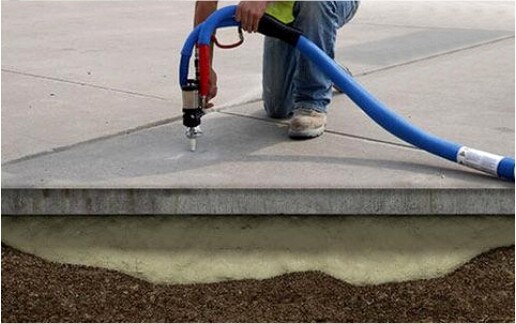If you’ve ever noticed your driveway, patio, or sidewalk sinking or becoming uneven, you might be dealing with a common issue called concrete settlement. One effective solution to this problem is slabjacking, a technique used to lift sunken concrete slabs and restore them to their original position. But what exactly is slabjacking? What types are available, and is it the right fix for your situation? This guide covers everything you need to know, including its types, benefits, drawbacks, and frequently asked questions.
What Is Slabjacking?
Slabjacking, also known as mudjacking or concrete lifting, is a method used to raise sunken or uneven concrete slabs by injecting a lifting material underneath them. Over time, concrete surfaces can settle due to soil erosion, poor compaction, or water infiltration. Slabjacking helps correct these problems without the need to replace the entire slab.
The process involves:
- Drilling small holes into the sunken concrete.
- Pumping a specialized material underneath the slab through these holes.
- As the material expands or fills the voids, it lifts the concrete back to its proper level.
It’s a quick and cost-effective alternative to full concrete replacement, often used on driveways, sidewalks, garage floors, and even home foundations.
Types of Slabjacking
Slabjacking methods vary depending on the type of material used and the lifting technique. Here are the main types:
1. Mudjacking
- Material Used: A mixture of water, soil, sand, and cement (called “slurry”).
- How It Works: The slurry is pumped under the slab to fill gaps and push the concrete upward.
- Best For: Residential driveways, patios, and sidewalks.
- Pros: Economical and effective.
- Cons: Heavier material may cause further soil compaction over time.
2. Polyurethane Foam Injection (Foam Jacking)
- Material Used: Expanding polyurethane foam.
- How It Works: The foam is injected through small holes and expands to fill voids and lift the slab.
- Best For: Both residential and commercial use, including structural foundation repairs.
- Pros: Lightweight, quick-curing, water-resistant, and long-lasting.
- Cons: More expensive than mudjacking; not suitable for all soil types.
3. Pressure Grouting
- Material Used: Cement-based grout or chemical grout.
- How It Works: Pressurized grouting is used to stabilize soil and lift slabs, often used for heavy-duty commercial or industrial repairs.
- Best For: Large structures, highways, or load-bearing foundations.
- Pros: Provides structural strength and soil stabilization.
- Cons: Requires specialized equipment and expertise.
Pros of Slabjacking
Slabjacking comes with several notable advantages, making it a preferred method for many property owners:
✅ Cost-Effective
Slabjacking typically costs 30-50% less than replacing concrete slabs, saving time and money.
✅ Quick and Efficient
Most slabjacking jobs can be completed within a few hours, with minimal disruption to your daily routine.
✅ Environmentally Friendly
Reusing the existing concrete reduces the need for demolition and disposal, making it a more eco-friendly option.
✅ Less Mess
Unlike full replacement, slabjacking doesn’t involve heavy demolition or removal of concrete debris.
✅ Long-Lasting Results
When properly done, especially with polyurethane foam, the results can last for years without requiring additional maintenance.
Cons of Slabjacking
While slabjacking is highly beneficial, it’s not without a few downsides:
❌ Not Suitable for Severely Damaged Concrete
If your slab is cracked or deteriorated beyond repair, lifting it might not be enough. Replacement may be necessary.
❌ Potential for Future Settlement
If the underlying soil isn’t stabilized properly, the slab could settle again over time—especially with mudjacking.
❌ Aesthetic Considerations
Although small, the drilled holes used in slabjacking remain visible unless patched well.
❌ Limited Use in Certain Conditions
Some soil types, water-logged environments, or heavy structural loads may limit the effectiveness of slabjacking.
Slabjacking vs. Replacement: Which One Should You Choose?
Here’s a quick comparison to help decide between slabjacking and full concrete replacement:
| Criteria | Slabjacking | Concrete Replacement |
|---|---|---|
| Cost | Lower | Higher |
| Time Required | Few hours | Several days |
| Disruption | Minimal | Major |
| Longevity | Long (with foam) | Very long |
| Aesthetic Result | Minor patches visible | Brand-new look |
| Eco-Friendliness | High | Low |
If your slab is structurally sound but uneven, slabjacking is usually the better and more economical choice.
Frequently Asked Questions (FAQ)
1. How much does slabjacking cost?
On average, slabjacking costs between $500 and $2,000 depending on the size of the area and the method used (mudjacking is cheaper, foam jacking is pricier).
2. Is slabjacking a permanent fix?
Yes, especially with polyurethane foam, the results can last 10-15 years or more. However, soil conditions and external factors can affect durability.
3. Can slabjacking be done in cold weather?
It can be done in cool weather, but extremely cold conditions may limit the curing process of the injected materials. Foam jacking is more weather-resistant than mudjacking.
4. Will slabjacking damage my landscaping?
No. The process requires only small holes drilled into the slab and doesn’t disturb surrounding areas.
5. How soon can I use the area after slabjacking?
With polyurethane foam, you can typically use the slab within 15 minutes to an hour. Mudjacking may require several hours to cure.
6. Are the holes noticeable after slabjacking?
The holes (usually 5/8″ to 1″ in diameter) can be patched and made less visible, but they may not be completely hidden.
Conclusion
Slabjacking is a proven, cost-effective method for leveling sunken concrete surfaces without the need for total replacement. Whether you opt for traditional mudjacking or advanced polyurethane foam injection, this technique offers quick, durable results with minimal hassle. As with any home repair, choosing the right contractor and method for your specific needs is key.
If you’re dealing with uneven concrete around your home or business, consider slabjacking before tearing it all out—your wallet (and schedule) might thank you!

